Our feelings about decks drive our discussion of them. This, in turn, forms our impression of the metagame. We get bored with Valakut and excited by Frost Titans, so we talk about how Valakut is “drifting out” of the metagame and U/R/G Jace decks, or U/B Control decks, are taking over.
Similarly, if we think Vampires is a deck for little kids, then we’re disinclined to give it credit as a “real” deck. Thus, anyone who played it with some amount of success has to have been “lucky,” and there isn’t any real point in thinking about how we’d play against it if we ran into it at the next big tournament.
You might guess from my tone that I think either approach is likely to see us running afoul of our own foolishness at the very next tournament we attend.
This week we’ll have the normal metagame roundup, followed by a fairly detailed discussion of the state of the Valakut archetype.
But first, I’d like to start with a cautionary (and awesome) tale about correlation and causation.
Ignaz Semmelweis and the best deck
It’s tremendously tempting for us to look at the decks that have made it into the upper tiers of tournaments and decide that they must be there
because
they’re the best decks. Setting aside the fact that a stellar Limited performance can seriously undercut this assumption in modern mixed-format Pro Tours, there are still issues with thinking this way. People bring decks they
want
to play, rather than decks that are somehow objectively more powerful than everything else.
Some players actively seek decks that involve many decisions, in the belief that they are better decision makers than their opponents, so this leverages their special edge. Other players look for decks that goldfish tremendously well, since this means they will “randomly win” more games.
At the same time, genuinely bad decks tend not to make it into the upper tiers, so clearly there’s some value in comparing upper and lower.
Semmelweis?
What does that have to do with a Hungarian doctor working in Vienna in the mid-1800s?
So, the 19th century was a really crappy time to be a pregnant woman, especially if you were somehow talked into giving birth in a hospital, where your death rate during childbirth could be up to ten times higher than if you’d just stayed home. The Vienna General Hospital had two birth wards, one with a “typical” death rate of about 3% (yes, nearly one in thirty women
died
after giving birth), the other with a horrifying
death rate of 30% (one in
three
). In either case, the women died from a nasty fever, and a young doc named Ignaz Semmelweis wanted to know
why.
So, he had an obvious correlation to work with. Ward 1 had a 3% death rate; Ward 2 had a 30% death rate. So what was different between them? Well, Ward 2 had student doctors, was a little more crowded, and priests had to walk through it to give last rites to dying folks elsewhere.
In the 19th century, not knowing anything about bacteria, these all seemed like reasonable causes. However, instead of assuming that any one of them was the cause, Semmelweis tested them out. He opened up the space, rerouted the priests, taught the students to be gentler… and nothing worked. Eventually, a friend of his cut himself during an autopsy and died of a fever that seemed a lot like the one women died of post-childbirth.
New theory time — student docs get “dead people stuff” on their hands and pass it on to the new moms.
Semmelweis had the student docs wash their hands between doing an autopsy and delivering a baby (they hadn’t been, before that), and voila, problem solved.
So, the take-home is two-fold.
First, look at the metagame and form ideas, but then playtest them to make sure you’re not being led astray by factors you can’t account for.
Second, wash your damn hands. Seriously. By just the third round of a Magic tournament, once your opponent shuffles your deck, your cards have effectively been touched by seven other people… at least if no one washed their hands in the interim.
Okay, back to Magic, and…
The metagame round up
The information this week covers the period from November 1 through November 11, and includes the usual host of MTGO Daily events as well as the SCG Open: Boston and three MTGO Premier Events. This gives us some 689 decklists performing 3-1 in Dailies, 172 hitting 4-0 in the Dailies, and 32 lists that Top 8ed some form of Premier event, for a total of 893 decklists.
The high-level view
Here’s the high-level take on the overall metagame, split between the Premier Events, 4-0 Dailies, and 3-1 Dailies, as before.
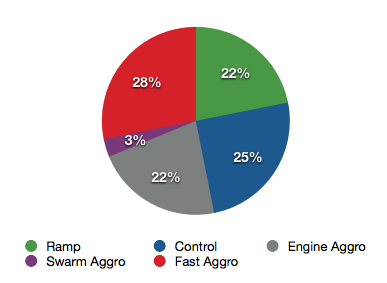
That’s our archetype breakdown across the four Premier Event Top 8s that fell within our current period. I’ve gone ahead and renamed “Slow Aggro” to the more accurate “Engine Aggro,” which encompasses both Vampires and Fauna Shaman decks. The distinction within the aggro categories is between decks that use low-cost creatures and burn (“Fast Aggro”), those that fill the board with creatures (“Swarm Aggro”), and the decks that use some combination of cards to generate explosive kills (“Engine Aggro”).
Here’s what the Premier breakdown looked like the last time we checked in:
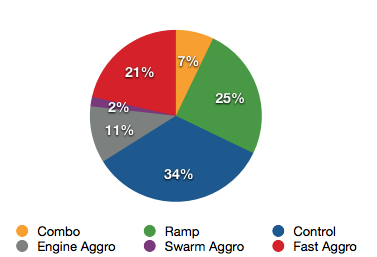
Notably, the overall slice of the Premier metagame going to aggro decks went up rather a bit, taking home half of the top slots in this period as opposed to about a third last time. Ramp decks retained their relative position, meaning that control and combo had their lunch money stolen this time around.
But as always, we need to consider that Top 8s, while likely to reflect “reasonable” decks, are subject to
bottlenecking
effects. So what’s going on over in the Dailies?
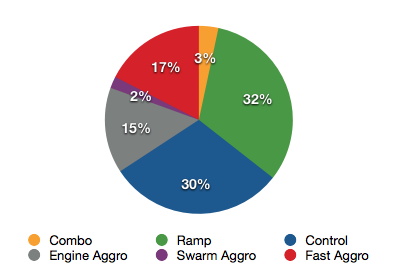
Those are the 4-0 performers from this reporting period, and here are the 4-0 performers from last time:
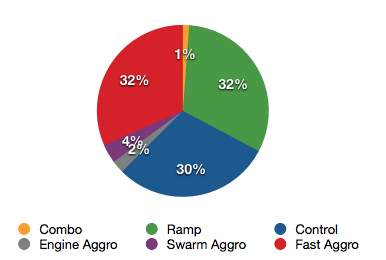
This is a fascinating period-to-period change, and I have a guess about what it reflects about underlying player structure, at least on MTGO.
The ramp and control slices of the metagame remained essentially stable, and the
overall
aggro slice is nearly constant at just over a third of the metagame… but a lot of players appear to have traded in their Steppe Lynxes and Goblin Guides for Pulse Trackers and Kalastria Highborns. My hypothesis — that is, my best informed guess — would be that we’re getting to see some confluence of player deck style preference and cost issues at work here. Of course, my guess is less valuable than what we can
see
, which is that if you’re trying to carve your way through the early rounds of a tournament, and you aren’t prepared for little, fanged men, you’re in trouble.
Speaking of early rounds, here are the 3-1s from this periods Dailies:
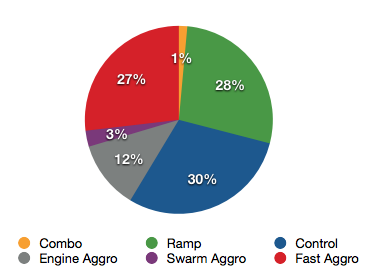
Compare this, once more, to this period’s 4-0s:

This, too, may reflect player structural issues more than anything else. If you
can’t
switch to the Vampires deck, you may be stuck playing that increasingly outdated version of fast aggro that you’ve been running. Again, that’s just my guess, but I do think we’re seeing a useful tournament structure in which the
type
of aggro deck you can expect to face will change as you make your way up the standings and into the later tournament rounds.
Enriching unexpected archetypes
As I said in the intro, we put together our stories about how Magic works from our impressions, and this can lead us to decide that a deck is basically “done,” or that another deck is stupid and not worth thinking about. One of the biases that’s genuinely easy to pick up if you read a lot of Magic content is the idea that “good players play control,” from which you’d expect that there are a lot of scrubs running those aggro decks in the 3-1s and 4-0s, and it’s the good players who will, say, play the dominant control deck and
win big events.
In that light, it’s interesting to look at the chunk of the metagame going to specific deck archetypes at each of the levels we’re surveying:
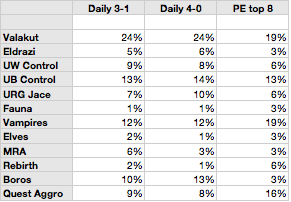
A quick note — I cut out the “other” category from the Dailies and focused on just the major archetypes.
My main take-home from those percentages would be the concept of bottlenecking, again. If you didn’t click on the link above, bottlenecking is, essentially, the idea that a population that goes through some kind of significant cut-down — say, going from a couple hundred players to a Top 8
— artificially losing relevant, representative parts of the population. In Magic terms, that means that Top 8s don’t accurately report on
all
the best decks, just
some
of the “good enough” decks.
So, with that in mind, I found it fascinating that Quest Aggro and Vampires decks could be “good enough” to break through to the Top 8 in numbers well out of step with their representation in the metagame in general. In contrast, decks we might expect to be “best,” such as U/R/G Jace and U/B Control plodded along with results at the Premier level that basically match their representation at the 3-1 level.
Of course, we’re referring to archetypes here. But we all know that people misbuild decks all the time. The 3-1 Jace player may be making a bad Jace deck, whereas the 4-0 or Premier Jace player might have the optimal Jace deck.
I’m always curious about that question.
Breaking down Valakut
So, all builds are clearly not the same. They’re empirically not the same — we debate highly detailed maindeck and sideboard card choices all the time, and don’t all sit down with the same 75 at each tournament we attend. They’re also qualitatively dissimilar as judged from outcomes. Some versions of the same archetype just do better than others.
Are there key differentiators between “good” and “better” Valakut decks? Can we learn anything, for example, by comparing decks form the Dailies with those from Premier Top 8s?
Comparing 4-0s and Top 8s
The question is pretty simple — are there cards, or card number choices that appear in Top 8 decks with more or less frequency than in decks that 4-0 MTGO Dailies?
To take a look at this, I cataloged the cards in the six Valakut decks that made Top 8 appearances in Premier events and then compared them to the cards appearing in twenty-four Valakut decks that managed to 4-0 MTGO Dailies in the same time frame. In collecting the lists from the Dailies, I didn’t tally more than one list from the same player, since a ringer 4-0ing Dailies with his or her pet list is providing us with an entirely different sort of data than what we’re trying to collect.
For the record, the best Valakut performer from the Dailies over the reporting period was Yunhao_Wu_CHN, who 4-0ed three times. Good for you.
The easiest intuitive way to look at this kind of comparison is by comparing “average” decklists. Essentially, we add up all the numbers of cards across the deck lists in a category — for example, all the Premier Top 8 lists — and then average them out to yield an intuitive “typical” version of the deck in question.
Creatures (10)
Lands (28)
Spells (21)

Yes, that’s a 59-card maindeck with a 17-card sideboard. Remember that this is just an average across the Premier Top 8 lists and not a real deck list. That said, it’s pretty close to a real list — you could shuffle the cards around a little bit and actually have a solid Valakut deck (see below for more).
Also notice that averaging necessarily makes for some quirks, like a single Overgrown Battlement, or the curious 1-1 split of Act of Treason and Mark of Mutiny in the sideboard. This reflects a bunch of binary decisions being averaged out. People tend to play four Battlements or no Battlements and to have two of either Act
or
Mark in their sideboard.
Now, compare to the average from the Dailies:
Creatures (10)
Lands (28)
Spells (22)

This time, averaging blesses us with a 60-card maindeck, but leaves us three cards short in the side. So it goes.
There are a couple standout features we can glean from this comparison.
First, decks in the Top 8 seem to be paying a lot more attention to dealing with assaults by fast aggro builds. There are a surprising number of Lightning Bolts relegated to the sideboard among the Dailies, as well as a similarly surprising number of decks featuring a reduced number of Pyroclasms, whereas quad Pyroclasm is
du rigeur
among Premier Valakut lists. In fairness, 75% of the Daily Valakut lists have four copies of Pyroclasm, so it’s not as if they’re all choosing to run 2-3 copies each. The Premier Valakut lists also are far more likely to actually have Obstinate Baloth in the sideboard.
All in all, this focus on defeating fast aggro feels correct if we consider the metagame context I described above. If you want to make it through a six, seven, or eight-round tournament, you will face aggro, and it will pay to have Pyroclasms, Baloths, and Bolts.
Especially if, you know, the opponent is running Vampires.
Both sets of Valakut decks run an average of sixteen acceleration spells. Cultivate, Explore, and Khalni Heart Expedition are all basically givens at four copies each, whereas there’s a little more variability in the count and presence or absence of Harrow and Overgrown Battlement.
The typical Premier Valakut list also uses fewer copies of Summoning Trap than the typical Daily list, averaging one less in the maindeck.
I’ll close this section out with the observation that interested me the most. Only one of the Premier lists ran any copies of Raging Ravine at all. This fits with an impression I started to get as I reviewed the lists, that the Premier lists focused more on the “pure” Valakut kill, ignoring unrelated victory conditions such as other fatties (such as Wurmcoil Engine) or creature duals.
Cards not appearing in…
If that impression is correct, that the Premier Valakut lists focus on a “pure” Valakut kill, we might expect to see a bunch of cards appearing solely in the Daily lists. We might even go so far as to call them “distractions.”
Turns out, those cards exist.
Cards appearing only in Daily lists
Inferno Titan
Joraga Treespeaker
Kozilek, Butcher of Truth
Terastodon
Tunnel Ignus
Arc Trail
Flame Slash
Growth Spasm
Memoricide
Mindslaver
Ratchet Bomb
Swamp
Verdant Catacombs
There’s a much shorter list going in the other direction as well.
Cards appearing only in Premier lists
Artisan of Kozilek
Mark of Mutiny
Once again, we need to remember that we aren’t necessarily seeing a readout on the right card choices in those Premier Top 8s. We may, instead, be seeing the consequences of players being more comfortable experimenting with different cards in Dailies than in Premier events.
That said, many of the cards above could be reasonably described as “alternate ways to achieve the same goal.” Flame Slash sometimes replaces Lightning Bolt or, more worryingly Pyroclasm. Ratchet Bomb can be thought of as a Pyroclasm that trades slowness for the ability to eventually hit bigger targets. Growth Spasm is sort of a Cultivate, with the advantage of providing a potential chump blocker, but the notable disadvantage of not being able to place Valakut ammunition into your hand.
So we could also call them “worse ways to achieve the same goal,” if we were feeling less charitable.
Memoricide and Tunnel Ignus both attempt to address the mirror match by disrupting the opponent’s game. In contrast, the default “Premier” position is clearly to attempt to simply out-accelerate the opponent for the win, bolstered by the ability to steal their fatties.
From my reading, this reinforces the idea that the likely best way to play Valakut is to make card choices and plays that reinforce the power of the Valakut combo kill (where, to be clear, I mean both the Valakut kill itself and the pumped-Plant-tokens kill driven by Avenger of Zendikar). In doing this, we’re given room to build a sideboard that can massively reinforce our game against fast aggro decks that have the potential to outpace that combo kill.
Ideal Valakut
So, say you agree with me that we want to focus on the combo kill and avoid unnecessary distractions. What might our ideal Valakut list look like, at least for now?
Unsurprisingly, I’m going to start with the average Premier list, and then smooth things out appropriately. Here’s the list:
Creatures (10)
Lands (28)
Spells (22)
Sideboard

A proactive finish
At the end of the day, this kind of analysis still amounts to me telling a story about the metagame and Valakut’s place within it, albeit one seasoned with real data. However, I think it’s probably an accurate story. Valakut is not a solutions deck, so no tinkering with the “right” solutions will be better than simply making it as good as it can reasonably be at doing its thing — playing lands, playing more lands, and doing things that kill you because of those lands. So, my take-home from this week’s metagame might look something like this:
Expect to play against a lot of Valakut.
At the top tables, expect to play against combo-focused Valakut.
If you’re playing Valakut… focus on what matters. Play tight, and get the kill, and don’t worry about packing Memoricides and Wurmcoils.
And, of course, watch out for those Vampires. They’re everywhere.
